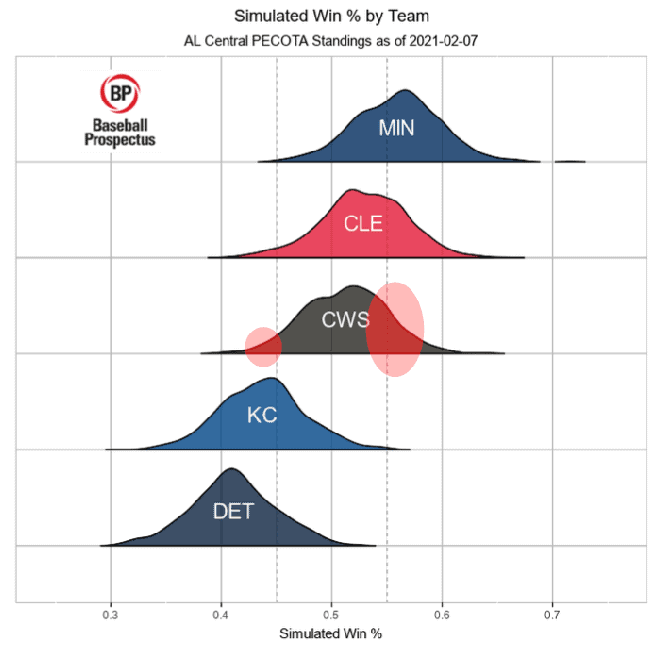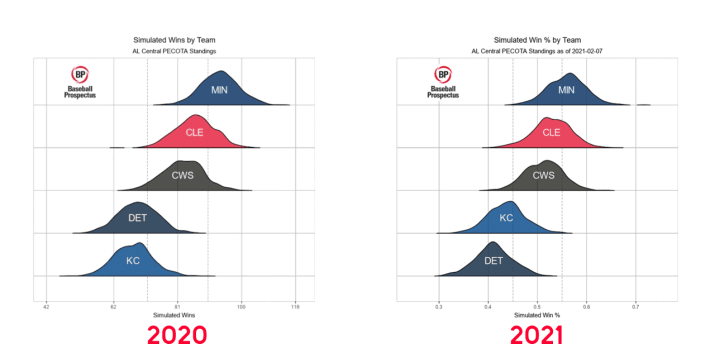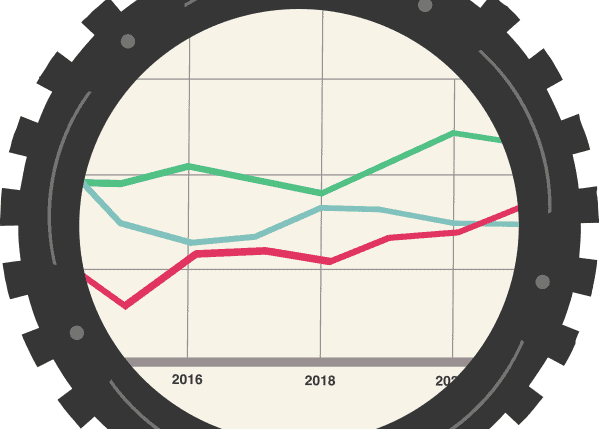After the White Sox shut out the Reds 5-0 on Sept. 19, they led the AL Central by three games with eight to play. Here's a look at the divisional standings afterward:
- White Sox, 34-18
- Twins, 32-22
- Indians, 28-24
Then the White Sox wrapped up the season by losing seven of those eight games, including a four-game sweep by the Indians that tilted the season series and tiebreaker in Cleveland's favor.
- Twins, 36-34
- Indians, 35-25
- White Sox, 35-25
On one hand, the White Sox handily beat their 60-game PECOTA projection of 31-29. Yet they couldn't outrun the estimation of the divisional order, which had the Sox finishing in third. Perhaps the system couldn't predict Rick Renteria's team melting down and losing composure, but one could argue that's one way a talent shortage manifests itself.
Anyway, I bring that up because PECOTA projected the White Sox for a third-place finish yet again, with a marginal improvement over their original 162-game projections in 2020.
| Team | 2020 | 2021 |
|---|---|---|
| Twins | 93-69 | 91-71 |
| Indians | 86-76 | 86-76 |
| White Sox | 83-79 | 83-79 |
The White Sox are improved, but not outside of a rounding error in the win column (82.5 to 83.1 wins). Surprised? I am. But rather than focusing on one number -- even if it's the result of 1,000 numbers -- I find PECOTA's accompanying win curves more illuminating. Sure enough, a map of the White Sox's simulated results shows how the big picture has them running in place, because the individual simulations have them running all over the place.

I've circled two areas. The front shoulder is much healthier than the one from last year's simulations, which dropped off a table well before the Twins started peaking. Here they are side-by-side for comparison.

That area captures all the ways the tumblers can click into place and turn the season into something special. The White Sox's 50th-percentile individual projections have a lot of underwhelming forecasts that can be beat. A few examples:
- Yoán Moncada hitting .243/.334/.426, with the algorithm understandably missing on the unique challenges posed by COVID-19.
- Tim Anderson hitting .271/.306/.438, which is below his career line despite a .331/.357/.514 line the last two years.
- Andrew Vaughn being worth -0.6 WARP.
- Lucas Giolito projecting as the 19th-best pitcher in baseball.
- Dallas Keuchel barely being average (2.1 WARP).
BP has acknowledged the built-in volatility of this talent by centering an entire article on Michael Kopech's wildly erratic projections, and he's far from the only one on this roster who might swing from world-beater to world-weary in the same season. Maybe the same game.
The other circle covers the greater number of (under)achievable pessimistic outcomes. The curve's initial ascent is steeper than the other AL Central teams, which shows there are a greater number of scenarios where a critical amount of Plan A's fall through.
The White Sox have a lineup that's generally walk-averse with inconsistent-at-best defensive showings, which makes them hard to individually project for stardom. Beyond the stylistic objections, Vaughn hasn't competed against other teams above A-ball, and he's getting the bulk of the DH plate appearances, with no clearly better options ahead or behind him. Michael Kopech is the only MLB-ready starter in reserve. One or two targeted injuries can send this whole roster calving into the sea, and the Sox might regret spending the most money on a closer with few games to save.
You could probably distill a lot of the systemic disagreement over how the White Sox built their roster down to settling for in-house solutions at DH, with Vaughn leading the way. PECOTA is the low man, but even the most optimistic projection on his FanGraphs page doesn't paint a great picture.
- PECOTA: .220/.289/.335
- ZiPS: .235/.311/.374
- THE BAT: .249/.321/.405
Plug that into a bat-only spot in the lineup, and it's going to sink the readings. Imagine this dialogue:
WHITE SOX: We're confident in Andrew Vaughn as our primary DH for most of the season.
PECOTA: Are you sure?
WHITE SOX: Yes.
PECOTA: Because you might not like--
WHITE SOX: Do it.
PECOTA: OK, but only because you said so.
[PECOTA PROJECTS 83 WINS FOR WHITE SOX]
WHITE SOX: I'd like to speak to the manager.
Two of those lines represent improvement over 2020's Edwin Encarnación-led group, but then again, said Encarnación-led group was supposed to be an easy upgrade over the previous season. Instead, this happened:
- 2019: .205/.285/.356
- 2020: .148/.238/.350
A similar fate befell right field, where Nomar Mazara, despite all his flaws, couldn't be worse than what the Sox trotted out in 2019. And indeed, he wasn't ...
- 2019: .220/.277/.288
- 2020: .230/.284/.324
... but it illustrates the gap between an improvement and an upgrade. Going from "brutal" to "bad" qualifies as the former, but doesn't register as the latter on a meaningful scale. It left the White Sox seeking their third new right fielder in as many years, and they again didn't set their sights much higher on paper.
It wouldn't surprise me if Vaughn beat those projections handily, because his plate discipline is MLB-ready, and nobody really knows how to account for seasons spent at alternate training sites. It also wouldn't surprise me if he struggled, because it's unfair to expect immediate, quality MLB production from a guy with limited high-minors experience.
All in all, the White Sox have championship upside. Championship depth has yet to materialize. The PECOTA win number sounds low, but the curve helpfully illustrates why one chunk of the fan base is arguing with another. For me, it's not too cynical to make the White Sox show their work, because they couldn't quite outrun the system even over 60 games. Adding 102 more games ups the degree of difficulty, which is why I hoped the White Sox would make more meaningful additions to make everything a little easier on themselves.





